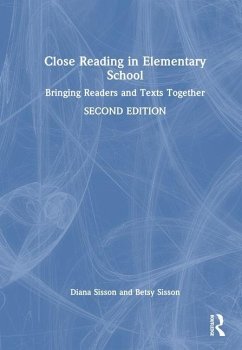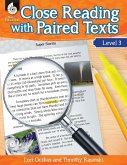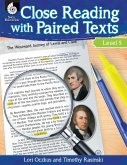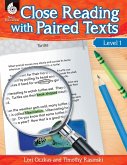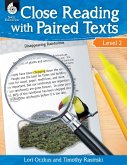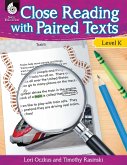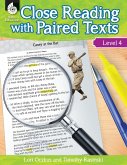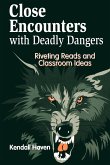- Gebundenes Buch
- Merkliste
- Auf die Merkliste
- Bewerten Bewerten
- Teilen
- Produkt teilen
- Produkterinnerung
- Produkterinnerung
This book provides step-by-step strategies and scaffolds for teaching close reading and improving students' comprehension of complex texts.
Andere Kunden interessierten sich auch für
![Close Reading with Paired Texts Level 3 Close Reading with Paired Texts Level 3]() Lori OczkusClose Reading with Paired Texts Level 323,99 €
Lori OczkusClose Reading with Paired Texts Level 323,99 €![Close Reading with Paired Texts Level 5 Close Reading with Paired Texts Level 5]() Lori OczkusClose Reading with Paired Texts Level 523,99 €
Lori OczkusClose Reading with Paired Texts Level 523,99 €![Close Reading with Paired Texts Level 1 Close Reading with Paired Texts Level 1]() Lori OczkusClose Reading with Paired Texts Level 123,99 €
Lori OczkusClose Reading with Paired Texts Level 123,99 €![Close Reading with Paired Texts Level 2 Close Reading with Paired Texts Level 2]() Lori OczkusClose Reading with Paired Texts Level 223,99 €
Lori OczkusClose Reading with Paired Texts Level 223,99 €![Close Reading with Paired Texts Level K Close Reading with Paired Texts Level K]() Lori OczkusClose Reading with Paired Texts Level K23,99 €
Lori OczkusClose Reading with Paired Texts Level K23,99 €![Close Reading with Paired Texts Level 4 Close Reading with Paired Texts Level 4]() Lori OczkusClose Reading with Paired Texts Level 423,99 €
Lori OczkusClose Reading with Paired Texts Level 423,99 €![Close Encounters with Deadly Dangers Close Encounters with Deadly Dangers]() Kendall HavenClose Encounters with Deadly Dangers37,99 €
Kendall HavenClose Encounters with Deadly Dangers37,99 €-
-
-
This book provides step-by-step strategies and scaffolds for teaching close reading and improving students' comprehension of complex texts.
Hinweis: Dieser Artikel kann nur an eine deutsche Lieferadresse ausgeliefert werden.
Hinweis: Dieser Artikel kann nur an eine deutsche Lieferadresse ausgeliefert werden.
Produktdetails
- Produktdetails
- Verlag: Routledge
- 2. Auflage
- Seitenzahl: 196
- Erscheinungstermin: 6. März 2024
- Englisch
- Abmessung: 260mm x 183mm x 15mm
- Gewicht: 574g
- ISBN-13: 9781032528939
- ISBN-10: 1032528931
- Artikelnr.: 69434276
- Herstellerkennzeichnung
- Libri GmbH
- Europaallee 1
- 36244 Bad Hersfeld
- gpsr@libri.de
- Verlag: Routledge
- 2. Auflage
- Seitenzahl: 196
- Erscheinungstermin: 6. März 2024
- Englisch
- Abmessung: 260mm x 183mm x 15mm
- Gewicht: 574g
- ISBN-13: 9781032528939
- ISBN-10: 1032528931
- Artikelnr.: 69434276
- Herstellerkennzeichnung
- Libri GmbH
- Europaallee 1
- 36244 Bad Hersfeld
- gpsr@libri.de
Diana Sisson and Betsy Sisson, Ed.D.s, are international literacy consultants focusing on professional development and school improvement. They also serve as adjunct professors in the fields of teacher preparation, curriculum and instruction, educational research in literacy, and literacy instruction.
Preface
Meet the Authors
PART I Understanding Close Reading
Chapter 1 Defining Complex Text in the Classroom
Why Is Text Complexity a Significant Factor in Reading Instruction Today?
Measuring Text Complexity
The Essence of Text Complexity
Summary
Book Study: Reflection Questions
Chapter 2 Close Reading: Historical Perspectives and Contemporary Practices
Historical Context
Close Reading Comes to American Classrooms
Reader Response Theory
The Return of Close Reading
Summary
Book Study: Reflection Questions
Part II Close Reading in the Classroom
Chapter 3 An Overview of Close Reading Strategies
Ten Steps to Creating a Close Reading Lesson
Plan the Implementation
Scaffold the Process
Summary
Book Study: Reflection Questions
Chapter 4 Reading Across Literary and Informational Genres
Literary Genres
Informational Genres
Summary
Book Study: Reflection Questions
Chapter 5 Strengthening Reading Through Targeted Comprehension Skills
Reading for Details Using Both Literal and Inferential Understanding
Theme, Main Idea, and Summarization
Narrative Elements
Text Structure
Point of View
Diverse Text Formats and Media
Evaluate Arguments in Text
Comparing and Contrasting Multiple Texts on the Same Topic
Summary
Book Study: Reflection Questions
Chapter 6 Accelerating Learning With Increasing Levels of Rigor
Bloom's Taxonomy
Webb's DOK Levels
Differentiating Academic Rigor
Summary
Book Study: Reflection Questions
Chapter 7 Looking Deeper at Digital Text
Evolution of Reading
The Digital Brain
Delving Into Digital Texts
Academic Benefits of the Social Aspect of Reading
The Use of Writing as a Physical Interaction With Digital Learning
Summary
Book Study: Reflection Questions
Part III Linking Close Reading With Close Talks and Close Writes
Chapter 8 Using Close Talks to Deepen Understanding
The Power of Questioning
Close Talks
Text
Questions
Students
Teacher
Preparing a Close Talk
Guidelines for Participating in a Close Talk
Close Talk Procedure
Close Talk Participation Rubric
Benefits of Close Talk
Summary
Book Study: Reflection Questions
Chapter 9 Close Writes as a Springboard Into Student-Generated Writing
Reading-Writing Connection
The Close Write Model
Summary
Book Study: Reflection Questions
Chapter IV The Independent Reader
Chapter 10 Building the Independent Reader
The Power of the Gradual Release of Responsibility
Teacher Modeling
Interactive Think Alouds
Guided Use of Whole-Class Close Reading Framework With Shared Text
Differentiating the Close Reading Process in Small Groups and Paired
Reading
Using Feedback to Elevate Student Thinking
The Independent Reader
Closing Thoughts on the Transformational Effect of Close Reading
Summary
Book Study: Reflection Questions
References
Meet the Authors
PART I Understanding Close Reading
Chapter 1 Defining Complex Text in the Classroom
Why Is Text Complexity a Significant Factor in Reading Instruction Today?
Measuring Text Complexity
The Essence of Text Complexity
Summary
Book Study: Reflection Questions
Chapter 2 Close Reading: Historical Perspectives and Contemporary Practices
Historical Context
Close Reading Comes to American Classrooms
Reader Response Theory
The Return of Close Reading
Summary
Book Study: Reflection Questions
Part II Close Reading in the Classroom
Chapter 3 An Overview of Close Reading Strategies
Ten Steps to Creating a Close Reading Lesson
Plan the Implementation
Scaffold the Process
Summary
Book Study: Reflection Questions
Chapter 4 Reading Across Literary and Informational Genres
Literary Genres
Informational Genres
Summary
Book Study: Reflection Questions
Chapter 5 Strengthening Reading Through Targeted Comprehension Skills
Reading for Details Using Both Literal and Inferential Understanding
Theme, Main Idea, and Summarization
Narrative Elements
Text Structure
Point of View
Diverse Text Formats and Media
Evaluate Arguments in Text
Comparing and Contrasting Multiple Texts on the Same Topic
Summary
Book Study: Reflection Questions
Chapter 6 Accelerating Learning With Increasing Levels of Rigor
Bloom's Taxonomy
Webb's DOK Levels
Differentiating Academic Rigor
Summary
Book Study: Reflection Questions
Chapter 7 Looking Deeper at Digital Text
Evolution of Reading
The Digital Brain
Delving Into Digital Texts
Academic Benefits of the Social Aspect of Reading
The Use of Writing as a Physical Interaction With Digital Learning
Summary
Book Study: Reflection Questions
Part III Linking Close Reading With Close Talks and Close Writes
Chapter 8 Using Close Talks to Deepen Understanding
The Power of Questioning
Close Talks
Text
Questions
Students
Teacher
Preparing a Close Talk
Guidelines for Participating in a Close Talk
Close Talk Procedure
Close Talk Participation Rubric
Benefits of Close Talk
Summary
Book Study: Reflection Questions
Chapter 9 Close Writes as a Springboard Into Student-Generated Writing
Reading-Writing Connection
The Close Write Model
Summary
Book Study: Reflection Questions
Chapter IV The Independent Reader
Chapter 10 Building the Independent Reader
The Power of the Gradual Release of Responsibility
Teacher Modeling
Interactive Think Alouds
Guided Use of Whole-Class Close Reading Framework With Shared Text
Differentiating the Close Reading Process in Small Groups and Paired
Reading
Using Feedback to Elevate Student Thinking
The Independent Reader
Closing Thoughts on the Transformational Effect of Close Reading
Summary
Book Study: Reflection Questions
References
Preface
Meet the Authors
PART I Understanding Close Reading
Chapter 1 Defining Complex Text in the Classroom
Why Is Text Complexity a Significant Factor in Reading Instruction Today?
Measuring Text Complexity
The Essence of Text Complexity
Summary
Book Study: Reflection Questions
Chapter 2 Close Reading: Historical Perspectives and Contemporary Practices
Historical Context
Close Reading Comes to American Classrooms
Reader Response Theory
The Return of Close Reading
Summary
Book Study: Reflection Questions
Part II Close Reading in the Classroom
Chapter 3 An Overview of Close Reading Strategies
Ten Steps to Creating a Close Reading Lesson
Plan the Implementation
Scaffold the Process
Summary
Book Study: Reflection Questions
Chapter 4 Reading Across Literary and Informational Genres
Literary Genres
Informational Genres
Summary
Book Study: Reflection Questions
Chapter 5 Strengthening Reading Through Targeted Comprehension Skills
Reading for Details Using Both Literal and Inferential Understanding
Theme, Main Idea, and Summarization
Narrative Elements
Text Structure
Point of View
Diverse Text Formats and Media
Evaluate Arguments in Text
Comparing and Contrasting Multiple Texts on the Same Topic
Summary
Book Study: Reflection Questions
Chapter 6 Accelerating Learning With Increasing Levels of Rigor
Bloom's Taxonomy
Webb's DOK Levels
Differentiating Academic Rigor
Summary
Book Study: Reflection Questions
Chapter 7 Looking Deeper at Digital Text
Evolution of Reading
The Digital Brain
Delving Into Digital Texts
Academic Benefits of the Social Aspect of Reading
The Use of Writing as a Physical Interaction With Digital Learning
Summary
Book Study: Reflection Questions
Part III Linking Close Reading With Close Talks and Close Writes
Chapter 8 Using Close Talks to Deepen Understanding
The Power of Questioning
Close Talks
Text
Questions
Students
Teacher
Preparing a Close Talk
Guidelines for Participating in a Close Talk
Close Talk Procedure
Close Talk Participation Rubric
Benefits of Close Talk
Summary
Book Study: Reflection Questions
Chapter 9 Close Writes as a Springboard Into Student-Generated Writing
Reading-Writing Connection
The Close Write Model
Summary
Book Study: Reflection Questions
Chapter IV The Independent Reader
Chapter 10 Building the Independent Reader
The Power of the Gradual Release of Responsibility
Teacher Modeling
Interactive Think Alouds
Guided Use of Whole-Class Close Reading Framework With Shared Text
Differentiating the Close Reading Process in Small Groups and Paired Reading
Using Feedback to Elevate Student Thinking
The Independent Reader
Closing Thoughts on the Transformational Effect of Close Reading
Summary
Book Study: Reflection Questions
References
Meet the Authors
PART I Understanding Close Reading
Chapter 1 Defining Complex Text in the Classroom
Why Is Text Complexity a Significant Factor in Reading Instruction Today?
Measuring Text Complexity
The Essence of Text Complexity
Summary
Book Study: Reflection Questions
Chapter 2 Close Reading: Historical Perspectives and Contemporary Practices
Historical Context
Close Reading Comes to American Classrooms
Reader Response Theory
The Return of Close Reading
Summary
Book Study: Reflection Questions
Part II Close Reading in the Classroom
Chapter 3 An Overview of Close Reading Strategies
Ten Steps to Creating a Close Reading Lesson
Plan the Implementation
Scaffold the Process
Summary
Book Study: Reflection Questions
Chapter 4 Reading Across Literary and Informational Genres
Literary Genres
Informational Genres
Summary
Book Study: Reflection Questions
Chapter 5 Strengthening Reading Through Targeted Comprehension Skills
Reading for Details Using Both Literal and Inferential Understanding
Theme, Main Idea, and Summarization
Narrative Elements
Text Structure
Point of View
Diverse Text Formats and Media
Evaluate Arguments in Text
Comparing and Contrasting Multiple Texts on the Same Topic
Summary
Book Study: Reflection Questions
Chapter 6 Accelerating Learning With Increasing Levels of Rigor
Bloom's Taxonomy
Webb's DOK Levels
Differentiating Academic Rigor
Summary
Book Study: Reflection Questions
Chapter 7 Looking Deeper at Digital Text
Evolution of Reading
The Digital Brain
Delving Into Digital Texts
Academic Benefits of the Social Aspect of Reading
The Use of Writing as a Physical Interaction With Digital Learning
Summary
Book Study: Reflection Questions
Part III Linking Close Reading With Close Talks and Close Writes
Chapter 8 Using Close Talks to Deepen Understanding
The Power of Questioning
Close Talks
Text
Questions
Students
Teacher
Preparing a Close Talk
Guidelines for Participating in a Close Talk
Close Talk Procedure
Close Talk Participation Rubric
Benefits of Close Talk
Summary
Book Study: Reflection Questions
Chapter 9 Close Writes as a Springboard Into Student-Generated Writing
Reading-Writing Connection
The Close Write Model
Summary
Book Study: Reflection Questions
Chapter IV The Independent Reader
Chapter 10 Building the Independent Reader
The Power of the Gradual Release of Responsibility
Teacher Modeling
Interactive Think Alouds
Guided Use of Whole-Class Close Reading Framework With Shared Text
Differentiating the Close Reading Process in Small Groups and Paired Reading
Using Feedback to Elevate Student Thinking
The Independent Reader
Closing Thoughts on the Transformational Effect of Close Reading
Summary
Book Study: Reflection Questions
References
Preface
Meet the Authors
PART I Understanding Close Reading
Chapter 1 Defining Complex Text in the Classroom
Why Is Text Complexity a Significant Factor in Reading Instruction Today?
Measuring Text Complexity
The Essence of Text Complexity
Summary
Book Study: Reflection Questions
Chapter 2 Close Reading: Historical Perspectives and Contemporary Practices
Historical Context
Close Reading Comes to American Classrooms
Reader Response Theory
The Return of Close Reading
Summary
Book Study: Reflection Questions
Part II Close Reading in the Classroom
Chapter 3 An Overview of Close Reading Strategies
Ten Steps to Creating a Close Reading Lesson
Plan the Implementation
Scaffold the Process
Summary
Book Study: Reflection Questions
Chapter 4 Reading Across Literary and Informational Genres
Literary Genres
Informational Genres
Summary
Book Study: Reflection Questions
Chapter 5 Strengthening Reading Through Targeted Comprehension Skills
Reading for Details Using Both Literal and Inferential Understanding
Theme, Main Idea, and Summarization
Narrative Elements
Text Structure
Point of View
Diverse Text Formats and Media
Evaluate Arguments in Text
Comparing and Contrasting Multiple Texts on the Same Topic
Summary
Book Study: Reflection Questions
Chapter 6 Accelerating Learning With Increasing Levels of Rigor
Bloom's Taxonomy
Webb's DOK Levels
Differentiating Academic Rigor
Summary
Book Study: Reflection Questions
Chapter 7 Looking Deeper at Digital Text
Evolution of Reading
The Digital Brain
Delving Into Digital Texts
Academic Benefits of the Social Aspect of Reading
The Use of Writing as a Physical Interaction With Digital Learning
Summary
Book Study: Reflection Questions
Part III Linking Close Reading With Close Talks and Close Writes
Chapter 8 Using Close Talks to Deepen Understanding
The Power of Questioning
Close Talks
Text
Questions
Students
Teacher
Preparing a Close Talk
Guidelines for Participating in a Close Talk
Close Talk Procedure
Close Talk Participation Rubric
Benefits of Close Talk
Summary
Book Study: Reflection Questions
Chapter 9 Close Writes as a Springboard Into Student-Generated Writing
Reading-Writing Connection
The Close Write Model
Summary
Book Study: Reflection Questions
Chapter IV The Independent Reader
Chapter 10 Building the Independent Reader
The Power of the Gradual Release of Responsibility
Teacher Modeling
Interactive Think Alouds
Guided Use of Whole-Class Close Reading Framework With Shared Text
Differentiating the Close Reading Process in Small Groups and Paired
Reading
Using Feedback to Elevate Student Thinking
The Independent Reader
Closing Thoughts on the Transformational Effect of Close Reading
Summary
Book Study: Reflection Questions
References
Meet the Authors
PART I Understanding Close Reading
Chapter 1 Defining Complex Text in the Classroom
Why Is Text Complexity a Significant Factor in Reading Instruction Today?
Measuring Text Complexity
The Essence of Text Complexity
Summary
Book Study: Reflection Questions
Chapter 2 Close Reading: Historical Perspectives and Contemporary Practices
Historical Context
Close Reading Comes to American Classrooms
Reader Response Theory
The Return of Close Reading
Summary
Book Study: Reflection Questions
Part II Close Reading in the Classroom
Chapter 3 An Overview of Close Reading Strategies
Ten Steps to Creating a Close Reading Lesson
Plan the Implementation
Scaffold the Process
Summary
Book Study: Reflection Questions
Chapter 4 Reading Across Literary and Informational Genres
Literary Genres
Informational Genres
Summary
Book Study: Reflection Questions
Chapter 5 Strengthening Reading Through Targeted Comprehension Skills
Reading for Details Using Both Literal and Inferential Understanding
Theme, Main Idea, and Summarization
Narrative Elements
Text Structure
Point of View
Diverse Text Formats and Media
Evaluate Arguments in Text
Comparing and Contrasting Multiple Texts on the Same Topic
Summary
Book Study: Reflection Questions
Chapter 6 Accelerating Learning With Increasing Levels of Rigor
Bloom's Taxonomy
Webb's DOK Levels
Differentiating Academic Rigor
Summary
Book Study: Reflection Questions
Chapter 7 Looking Deeper at Digital Text
Evolution of Reading
The Digital Brain
Delving Into Digital Texts
Academic Benefits of the Social Aspect of Reading
The Use of Writing as a Physical Interaction With Digital Learning
Summary
Book Study: Reflection Questions
Part III Linking Close Reading With Close Talks and Close Writes
Chapter 8 Using Close Talks to Deepen Understanding
The Power of Questioning
Close Talks
Text
Questions
Students
Teacher
Preparing a Close Talk
Guidelines for Participating in a Close Talk
Close Talk Procedure
Close Talk Participation Rubric
Benefits of Close Talk
Summary
Book Study: Reflection Questions
Chapter 9 Close Writes as a Springboard Into Student-Generated Writing
Reading-Writing Connection
The Close Write Model
Summary
Book Study: Reflection Questions
Chapter IV The Independent Reader
Chapter 10 Building the Independent Reader
The Power of the Gradual Release of Responsibility
Teacher Modeling
Interactive Think Alouds
Guided Use of Whole-Class Close Reading Framework With Shared Text
Differentiating the Close Reading Process in Small Groups and Paired
Reading
Using Feedback to Elevate Student Thinking
The Independent Reader
Closing Thoughts on the Transformational Effect of Close Reading
Summary
Book Study: Reflection Questions
References
Preface
Meet the Authors
PART I Understanding Close Reading
Chapter 1 Defining Complex Text in the Classroom
Why Is Text Complexity a Significant Factor in Reading Instruction Today?
Measuring Text Complexity
The Essence of Text Complexity
Summary
Book Study: Reflection Questions
Chapter 2 Close Reading: Historical Perspectives and Contemporary Practices
Historical Context
Close Reading Comes to American Classrooms
Reader Response Theory
The Return of Close Reading
Summary
Book Study: Reflection Questions
Part II Close Reading in the Classroom
Chapter 3 An Overview of Close Reading Strategies
Ten Steps to Creating a Close Reading Lesson
Plan the Implementation
Scaffold the Process
Summary
Book Study: Reflection Questions
Chapter 4 Reading Across Literary and Informational Genres
Literary Genres
Informational Genres
Summary
Book Study: Reflection Questions
Chapter 5 Strengthening Reading Through Targeted Comprehension Skills
Reading for Details Using Both Literal and Inferential Understanding
Theme, Main Idea, and Summarization
Narrative Elements
Text Structure
Point of View
Diverse Text Formats and Media
Evaluate Arguments in Text
Comparing and Contrasting Multiple Texts on the Same Topic
Summary
Book Study: Reflection Questions
Chapter 6 Accelerating Learning With Increasing Levels of Rigor
Bloom's Taxonomy
Webb's DOK Levels
Differentiating Academic Rigor
Summary
Book Study: Reflection Questions
Chapter 7 Looking Deeper at Digital Text
Evolution of Reading
The Digital Brain
Delving Into Digital Texts
Academic Benefits of the Social Aspect of Reading
The Use of Writing as a Physical Interaction With Digital Learning
Summary
Book Study: Reflection Questions
Part III Linking Close Reading With Close Talks and Close Writes
Chapter 8 Using Close Talks to Deepen Understanding
The Power of Questioning
Close Talks
Text
Questions
Students
Teacher
Preparing a Close Talk
Guidelines for Participating in a Close Talk
Close Talk Procedure
Close Talk Participation Rubric
Benefits of Close Talk
Summary
Book Study: Reflection Questions
Chapter 9 Close Writes as a Springboard Into Student-Generated Writing
Reading-Writing Connection
The Close Write Model
Summary
Book Study: Reflection Questions
Chapter IV The Independent Reader
Chapter 10 Building the Independent Reader
The Power of the Gradual Release of Responsibility
Teacher Modeling
Interactive Think Alouds
Guided Use of Whole-Class Close Reading Framework With Shared Text
Differentiating the Close Reading Process in Small Groups and Paired Reading
Using Feedback to Elevate Student Thinking
The Independent Reader
Closing Thoughts on the Transformational Effect of Close Reading
Summary
Book Study: Reflection Questions
References
Meet the Authors
PART I Understanding Close Reading
Chapter 1 Defining Complex Text in the Classroom
Why Is Text Complexity a Significant Factor in Reading Instruction Today?
Measuring Text Complexity
The Essence of Text Complexity
Summary
Book Study: Reflection Questions
Chapter 2 Close Reading: Historical Perspectives and Contemporary Practices
Historical Context
Close Reading Comes to American Classrooms
Reader Response Theory
The Return of Close Reading
Summary
Book Study: Reflection Questions
Part II Close Reading in the Classroom
Chapter 3 An Overview of Close Reading Strategies
Ten Steps to Creating a Close Reading Lesson
Plan the Implementation
Scaffold the Process
Summary
Book Study: Reflection Questions
Chapter 4 Reading Across Literary and Informational Genres
Literary Genres
Informational Genres
Summary
Book Study: Reflection Questions
Chapter 5 Strengthening Reading Through Targeted Comprehension Skills
Reading for Details Using Both Literal and Inferential Understanding
Theme, Main Idea, and Summarization
Narrative Elements
Text Structure
Point of View
Diverse Text Formats and Media
Evaluate Arguments in Text
Comparing and Contrasting Multiple Texts on the Same Topic
Summary
Book Study: Reflection Questions
Chapter 6 Accelerating Learning With Increasing Levels of Rigor
Bloom's Taxonomy
Webb's DOK Levels
Differentiating Academic Rigor
Summary
Book Study: Reflection Questions
Chapter 7 Looking Deeper at Digital Text
Evolution of Reading
The Digital Brain
Delving Into Digital Texts
Academic Benefits of the Social Aspect of Reading
The Use of Writing as a Physical Interaction With Digital Learning
Summary
Book Study: Reflection Questions
Part III Linking Close Reading With Close Talks and Close Writes
Chapter 8 Using Close Talks to Deepen Understanding
The Power of Questioning
Close Talks
Text
Questions
Students
Teacher
Preparing a Close Talk
Guidelines for Participating in a Close Talk
Close Talk Procedure
Close Talk Participation Rubric
Benefits of Close Talk
Summary
Book Study: Reflection Questions
Chapter 9 Close Writes as a Springboard Into Student-Generated Writing
Reading-Writing Connection
The Close Write Model
Summary
Book Study: Reflection Questions
Chapter IV The Independent Reader
Chapter 10 Building the Independent Reader
The Power of the Gradual Release of Responsibility
Teacher Modeling
Interactive Think Alouds
Guided Use of Whole-Class Close Reading Framework With Shared Text
Differentiating the Close Reading Process in Small Groups and Paired Reading
Using Feedback to Elevate Student Thinking
The Independent Reader
Closing Thoughts on the Transformational Effect of Close Reading
Summary
Book Study: Reflection Questions
References

